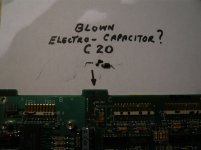harry
Experienced Member
I have recently had a bit of bad luck,whilst leaving my victor vicky powered on for some time, it suddenly decided to emit a nasty smell and finally die on me.
having opened up the case , I have found a blown capacitor on the floppy controller board, as it is now blown completely apart I have no values to read, to obtain a replacement. Close to this C20, is C19, same size same looking, but its values are a little confusing to me. It looks unlikely I can obtain any schematics, so I am going to try and find a replacement as C19. It reads +t310, K20%,3r3uf 15v. It measures aprox 3/16" dia.coloured black, and is axial leads, one end positive, position shows positive end on the board, as if electrolitic. Can anyone throw some light on what would be a suitable replacement, as searches throw up nothing similar. thanks..... Harry
having opened up the case , I have found a blown capacitor on the floppy controller board, as it is now blown completely apart I have no values to read, to obtain a replacement. Close to this C20, is C19, same size same looking, but its values are a little confusing to me. It looks unlikely I can obtain any schematics, so I am going to try and find a replacement as C19. It reads +t310, K20%,3r3uf 15v. It measures aprox 3/16" dia.coloured black, and is axial leads, one end positive, position shows positive end on the board, as if electrolitic. Can anyone throw some light on what would be a suitable replacement, as searches throw up nothing similar. thanks..... Harry

